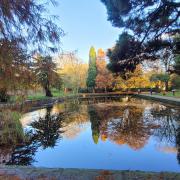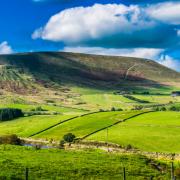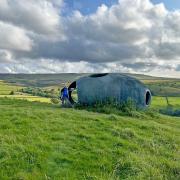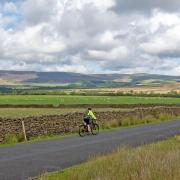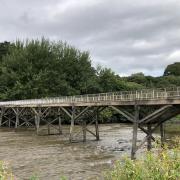Keith Carter explores a riverside walk through Kendal which takes in a castle, a ski slope and a remarkable number of bridges
Facts
Walk: A linear walk along the River Kent in Kendal
Distance: About 5 miles
Time to allow: 2�-3hrs
Map: OS Explorer OL7 The English Lakes South Eastern Area
Refreshments and toilets: At Abbot Hall Art Gallery
Useful web site: www.tudorhistory.org/parr
The river Kent rises above Kentmere Reservoir in the eastern Lakes andmakes its way into Morecambe Bay.
There are numerous bridges crossing the river and our walk touches, though doesn’t necessarily cross, ten of them if you include Nether Bridge, just downstream from our starting point at Abbot Hall. This could be called the Ten Bridges Walk which has a ring to it, if you like the names of things. The oldest, the longest, the biggest, the only one of its kind, we all like to attach these adjectives in order to impress and ten is a lot of bridges.
Kendal is outside the boundary of the National Park and is not officially in the Lake District which may be slightly to its disadvantage. To me it stands on its own reputation without needing the added kudos of being ‘in the Lakes’.
In recent years the town has admittedly lost some of its former pride having declined like everywhere else, yet the casual visitor cannot fail to be impressed by the crowded streets and constant through traffic.
Parking is a problem, though. There is very little on-street parking andspaces in the paid car parks are hotly contested. I have never found a space in the free car park by the river and although Booths car park is the best bet if you’re shopping, our walk starts at the Abbot Hall where cars can be left for up to three hours, just long enough to complete our walk.
Head down to the river past the entrance to the museum and art gallery where the programme of exhibitions through the year usually has something worth seeing. The permanent exhibition includes work by 19th century artists such as George Romney, a native of Kendal and visiting exhibitions recently have included major modern artists like Maggi Hambling and Ben Nicholson.
On reaching the river, turn left along the Riverside Walk - don’t take thefootbridge over the river, our second bridge after Nether Bridge downstream.
Don’t cross the next bridge, Miller Bridge, either but cross the road andwalk through the parked cars squeezed between the road and the river. At the next footbridge, cross the river and continue along the path on the other side to reach Stramongate Bridge opposite the Riverside Hotel.
Turn left and cross this bridge then turn down right to regain the riversidepath. The next bridge is the Victoria Bridge decorated with Kendal towncrests with the motto ‘pannus mihi panis’ which translates as ‘Wool isbread’, a reference to the time when Kendal was a centre for the wool trade.
The coarse cloth known as Kendal green, dyed using the woad plant, wasworn by the archers in the Middle Ages and is referred to by Shakespeare. Don’t cross this bridge but continue on the riverside walk. The river should be on your right.
One of the pleasures of riverside walking is watching the people coming and going, taking their ease, strolling, cycling and enjoying the open air. A mum with several kids was supervising the feeding of the seagulls, one species that positively does not need any extra help in finding its next meal. She hastily assured us that they were using stale bread, anxious in case we thought she was wasting good food. Perhaps she felt that it would help to save the planet by using up her old bread by feeding it to the gulls!
When the path splits, keep right beside the river and go under the railway bridge and at Dockwray Bridge, a footbridge, cross to the other side of the river and join the footpath, now with the river on your left.We have now left the built-up area and pass through mixed woodland but soon we become aware that the outskirts of town have sprouted factories that come down nearly to the river, rather spoiling the sense of being in open country.
The low hills to the north remind us there is wilder country ahead. Where the river forks, it is met by a tributary coming to join it, the little River Mint which we follow beside chain-link fencing as far as our tenth and last bridge, Mint Bridge taking the A6 north. Here we turn back, retracing our steps, heading back to the town and after crossing back over Stramongate Bridge, just before the next footbridge look for signs to Kendal Castle which is well worth the diversion.
Paths lead through rhododendrons to emerge at a local municipal tip and the entrance to Kendal Ski Club, a surprising discovery. I had no idea Kendal had a ski club. The practise slopes and ski-lift were busy and lower down quite young children were mastering the art of not falling over, with some success.
Steps climb the hillside emerging onto grass slopes that bring us to the ruin of the castle. The view from here is fantastic, the clustered grey buildings of the town below and the gentle Whinfell Ridge on the skyline with the high Lakeland fells to the north.
The castle was once the ancestral seat of the Parr family, best known because of Katherine Parr who married and survived Henry VIII. Her prayer book can be seen in Kendal Parish Church. She was married four times herself and died in childbirth in 1548 at the age of 36.
Return down the hillside past the ski club and turn left along Anyam Road to where the footbridge crosses the river to the gardens of Abbot Hall. Our walk has hopefully shown Kendal in a new light and opened up new possibilities for the auld grey town and the river that runs through it.
















